Paxar 9855 User Manual
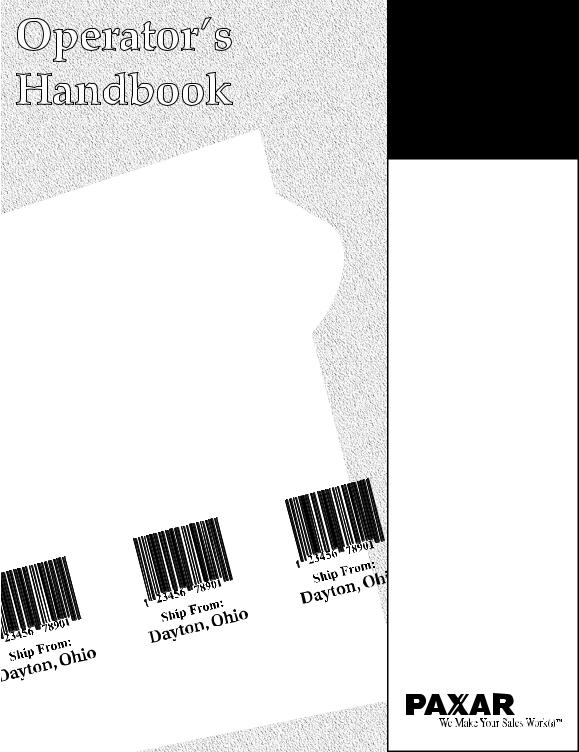
Paxar
9855 Printer
TC9855OH Rev. AB 4/03 ©2003 Paxar Americas, Inc. All rights reserved.
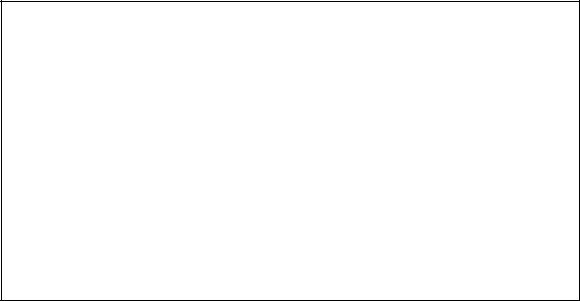
Each product and program carries a respective written warranty, the only warranty on which the customer can rely. Paxar reserves the right to make changes in the product, the programs, and their availability at any time and without notice. Although Paxar has made every effort to provide complete and accurate information in this manual, Paxar shall not be liable for any omissions or inaccuracies. Any update will be incorporated in a later edition of this manual.
©2003 Paxar Americas Inc. All rights reserved. No part of this publication may be reproduced, transmitted, stored in a retrieval system, or translated into any language in any form by any means, without the prior written permission of Paxar Americas, Inc.
WARNING
This equipment has been tested and found to comply with the limits for a Class A digital device, pursuant to Part 15 of the FCC Rules. These limits are designed to provide reasonable protection against harmful interference when the equipment is operated in a commercial environment. This equipment generates, uses, and can radiate radio frequency energy and, if not installed and used in accordance with the instruction manual, may cause harmful interference to radio communications. Operation of this equipment in a residential area is likely to cause harmful interference in which case the user will be required to correct the interference at his own expense.
CANADIAN D.O.C. WARNING
This digital apparatus does not exceed the Class A limits for radio noise emissions from digital apparatus set out in the Radio Interference Regulations of the Canadian Department of Communications.
Le présent appareil numérique n’émet pas de bruits radioélectriques dépassant les limites applicables aux appareils numériques de la classe A prescrites dans le Réglement sur le brouillage radioélectrique édicte par le ministère des Communications du Canada.
Trademarks
926, 932, 938, 939, 9800, 9855, and 9860 are trademarks of Paxar Americas, Inc. Paxar® and Paxar Americas are registered trademarks of Paxar Corporation.
Microsoft and MS-DOS are registered trademarks of Microsoft Corporation.
Windows and NT are registered trademarks of Microsoft in the U.S. and other countries. NetWare is a registered trademark of Novell, Inc. in the United States and other countries. Centronics is a registered trademark of Centronics Data Computer Corporation.
TrueType is a registered trademark of Apple Computer, Inc. Hewlett-Packard is a registered trademark of Hewlett-Packard Inc.
HP Jet Admin and HP Web Jet Admin are trademarks of Hewlett-Packard, Inc.
Adobe and Acrobat are trademarks of Adobe Systems Incorporated which may be registered in certain jurisdictions.
Other products are trademarks or registered trademarks of their respective countries and are hereby acknowledged.
Paxar Americas, Inc.
170 Monarch Lane
Miamisburg, OH 45342
TA B L E O F C O N T E N T S
GETTING STARTED. . . . . . . . . . . . . . . . . . . . . . . . . . . . . . . . . . . . . . . . . . . . . . . . . . . . . 1-1
Audience. . . . . . . . . . . . . . . . . . . . . . . . . . . . . . . . . . . . . . . . . . . . . . . . . . . . . . . 1-2
Unpacking the Printer . . . . . . . . . . . . . . . . . . . . . . . . . . . . . . . . . . . . . . . . . . . . . 1-2
Shipping the Printer . . . . . . . . . . . . . . . . . . . . . . . . . . . . . . . . . . . . . . . 1-2
9445 Printer Online Emulation . . . . . . . . . . . . . . . . . . . . . . . . . . . . . . . . . . . . . . 1-3
Ordering Programmer’s Manuals . . . . . . . . . . . . . . . . . . . . . . . . . . . . . . . . . . . . 1-3
About Monarch® MPCL Toolbox Utilities . . . . . . . . . . . . . . . . . . . . . . . . . . . . . . 1-3
Connecting the Power Cable . . . . . . . . . . . . . . . . . . . . . . . . . . . . . . . . . . . . . . . 1-3
Establishing Communications . . . . . . . . . . . . . . . . . . . . . . . . . . . . . . . . . . . . . . 1-4
Connecting the Communication Cable . . . . . . . . . . . . . . . . . . . . . . . . 1-4
Using the Control Panel . . . . . . . . . . . . . . . . . . . . . . . . . . . . . . . . . . . . . . . . . . . 1-5
Printer Status Lights. . . . . . . . . . . . . . . . . . . . . . . . . . . . . . . . . . . . . . . 1-5
Button Functions . . . . . . . . . . . . . . . . . . . . . . . . . . . . . . . . . . . . . . . . . 1-6
Display . . . . . . . . . . . . . . . . . . . . . . . . . . . . . . . . . . . . . . . . . . . . . . . . 1-7
Selecting a Function . . . . . . . . . . . . . . . . . . . . . . . . . . . . . . . . . . . . . . . . . . . . . . 1-7
Exiting an Option . . . . . . . . . . . . . . . . . . . . . . . . . . . . . . . . . . . . . . . . . . . . . . . . 1-8
LOADING SUPPLIES. . . . . . . . . . . . . . . . . . . . . . . . . . . . . . . . . . . . . . . . . . . . . . . . . . . . 2-1
Loading Labels or Tags. . . . . . . . . . . . . . . . . . . . . . . . . . . . . . . . . . . . . . . . . . . . 2-2 Using the Optional Tear Bar . . . . . . . . . . . . . . . . . . . . . . . . . . . . . . . . . . . . . . . . 2-8 Using Linerless Supply . . . . . . . . . . . . . . . . . . . . . . . . . . . . . . . . . . . . . . . . . . . . 2-9 Adding the Peel Edge or Shelf. . . . . . . . . . . . . . . . . . . . . . . . . . . . . . . 2-9 Using String Tag Supply . . . . . . . . . . . . . . . . . . . . . . . . . . . . . . . . . . . . . . . . . . 2-13 String Tag Considerations . . . . . . . . . . . . . . . . . . . . . . . . . . . . . . . . . 2-13
Adjusting the Wide/Narrow Knobs . . . . . . . . . . . . . . . . . . . . . . . . . . . . . . . . . . 2-16
i
LOADING RIBBON . . . . . . . . . . . . . . . . . . . . . . . . . . . . . . . . . . . . . . . . . . . . . . . . . . . . . |
3-1 |
Loading Ribbon . . . . . . . . . . . . . . . . . . . . . . . . . . . . . . . . . . . . . . . . . . . . . . . . . 3-2
Using a High Energy Ribbon . . . . . . . . . . . . . . . . . . . . . . . . . . . . . . . . . . . . . . . 3-4
High Energy Ribbon Limitations . . . . . . . . . . . . . . . . . . . . . . . . . . . . . 3-5
SETTING SUPPLY OPTIONS . . . . . . . . . . . . . . . . . . . . . . . . . . . . . . . . . . . . . . . . . . . . . |
4-1 |
Supply Type . . . . . . . . . . . . . . . . . . . . . . . . . . . . . . . . . . . . . . . . . . . . . . . . . . . . 4-2
Ribbon . . . . . . . . . . . . . . . . . . . . . . . . . . . . . . . . . . . . . . . . . . . . . . . . . . . . . . . . 4-3
Speed. . . . . . . . . . . . . . . . . . . . . . . . . . . . . . . . . . . . . . . . . . . . . . . . . . . . . . . . . 4-4
Feed Mode . . . . . . . . . . . . . . . . . . . . . . . . . . . . . . . . . . . . . . . . . . . . . . . . . . . . . 4-5
Backfeed . . . . . . . . . . . . . . . . . . . . . . . . . . . . . . . . . . . . . . . . . . . . . . . . . . . . . . 4-6
Positioning . . . . . . . . . . . . . . . . . . . . . . . . . . . . . . . . . . . . . . . . . . . . . . . . . . . . . 4-7
Print Position . . . . . . . . . . . . . . . . . . . . . . . . . . . . . . . . . . . . . . . . . . . . 4-7
Supply Position . . . . . . . . . . . . . . . . . . . . . . . . . . . . . . . . . . . . . . . . . . 4-9
Margin Position . . . . . . . . . . . . . . . . . . . . . . . . . . . . . . . . . . . . . . . . . 4-10
Cut Position . . . . . . . . . . . . . . . . . . . . . . . . . . . . . . . . . . . . . . . . . . . . 4-11
Dispense Position . . . . . . . . . . . . . . . . . . . . . . . . . . . . . . . . . . . . . . . 4-12
Backfeed Distance . . . . . . . . . . . . . . . . . . . . . . . . . . . . . . . . . . . . . . 4-13
Batch Separators . . . . . . . . . . . . . . . . . . . . . . . . . . . . . . . . . . . . . . . . . . . . . . . 4-14
Skip Index . . . . . . . . . . . . . . . . . . . . . . . . . . . . . . . . . . . . . . . . . . . . . . . . . . . . 4-15
Setting Contrast . . . . . . . . . . . . . . . . . . . . . . . . . . . . . . . . . . . . . . . . . . . . . . . . 4-16
Verifier . . . . . . . . . . . . . . . . . . . . . . . . . . . . . . . . . . . . . . . . . . . . . . . . . . . . . . . 4-18
COMMUNICATION VALUES. . . . . . . . . . . . . . . . . . . . . . . . . . . . . . . . . . . . . . . . . . . . . . 5-1
Baud Rate . . . . . . . . . . . . . . . . . . . . . . . . . . . . . . . . . . . . . . . . . . . . . . . . . . . . . 5-2 Word Length. . . . . . . . . . . . . . . . . . . . . . . . . . . . . . . . . . . . . . . . . . . . . . . . . . . . 5-2 Stop Bits. . . . . . . . . . . . . . . . . . . . . . . . . . . . . . . . . . . . . . . . . . . . . . . . . . . . . . . 5-4 Parity . . . . . . . . . . . . . . . . . . . . . . . . . . . . . . . . . . . . . . . . . . . . . . . . . . . . . . . . . 5-4 Flow Control. . . . . . . . . . . . . . . . . . . . . . . . . . . . . . . . . . . . . . . . . . . . . . . . . . . . 5-5 Reset to Default Values . . . . . . . . . . . . . . . . . . . . . . . . . . . . . . . . . . . . . . . . . . . 5-6
ii
Parallel Communications . . . . . . . . . . . . . . . . . . . . . . . . . . . . . . . . . . . . . . . . . . 5-6
Port. . . . . . . . . . . . . . . . . . . . . . . . . . . . . . . . . . . . . . . . . . . . . . . . . . . . 5-6
Mode . . . . . . . . . . . . . . . . . . . . . . . . . . . . . . . . . . . . . . . . . . . . . . . . . . 5-7
SETTING DEFAULTS . . . . . . . . . . . . . . . . . . . . . . . . . . . . . . . . . . . . . . . . . . . . . . . . . . . . 6-1
Monetary Sign . . . . . . . . . . . . . . . . . . . . . . . . . . . . . . . . . . . . . . . . . . . . . . . . . . 6-3
Secondary Sign . . . . . . . . . . . . . . . . . . . . . . . . . . . . . . . . . . . . . . . . . . . . . . . . . 6-4
Decimal Places. . . . . . . . . . . . . . . . . . . . . . . . . . . . . . . . . . . . . . . . . . . . . . . . . . 6-5
Slashed Zero . . . . . . . . . . . . . . . . . . . . . . . . . . . . . . . . . . . . . . . . . . . . . . . . . . . 6-6
Power-Up Mode . . . . . . . . . . . . . . . . . . . . . . . . . . . . . . . . . . . . . . . . . . . . . . . . . 6-6
Prompt Set . . . . . . . . . . . . . . . . . . . . . . . . . . . . . . . . . . . . . . . . . . . . . . . . . . . . . 6-7
Flash Storage . . . . . . . . . . . . . . . . . . . . . . . . . . . . . . . . . . . . . . . . . . . . . . . . . . . 6-8
Using Flash Memory. . . . . . . . . . . . . . . . . . . . . . . . . . . . . . . . . . . . . . . . . . . . . . 6-9
Formatting Flash Memory . . . . . . . . . . . . . . . . . . . . . . . . . . . . . . . . . . 6-9
Checking Available Flash Memory . . . . . . . . . . . . . . . . . . . . . . . . . . 6-10
Packing Flash Memory . . . . . . . . . . . . . . . . . . . . . . . . . . . . . . . . . . . 6-11
Memory Guidelines. . . . . . . . . . . . . . . . . . . . . . . . . . . . . . . . . . . . . . . . . . . . . . 6-12
Setting Batch Options. . . . . . . . . . . . . . . . . . . . . . . . . . . . . . . . . . . . . . . . . . . . 6-13
USING SCRIPTS . . . . . . . . . . . . . . . . . . . . . . . . . . . . . . . . . . . . . . . . . . . . . . . . . . . . . . . 7-1
Initial Script Startup Procedures. . . . . . . . . . . . . . . . . . . . . . . . . . . . . . . . . . . . . 7-1
Viewing Script Information . . . . . . . . . . . . . . . . . . . . . . . . . . . . . . . . . . . . . . . . . 7-2
Downloading a Script . . . . . . . . . . . . . . . . . . . . . . . . . . . . . . . . . . . . . . . . . . . . . 7-3
Enabling a Script . . . . . . . . . . . . . . . . . . . . . . . . . . . . . . . . . . . . . . . . . . . . . . . . 7-4
Deleting a Script . . . . . . . . . . . . . . . . . . . . . . . . . . . . . . . . . . . . . . . . . . . . . . . . . 7-5
Enabling Status Polling. . . . . . . . . . . . . . . . . . . . . . . . . . . . . . . . . . . . . . . . . . . . 7-6
Enabling Immediate Commands . . . . . . . . . . . . . . . . . . . . . . . . . . . . . . . . . . . . 7-6
iii
PRINTING. . . . . . . . . . . . . . . . . . . . . . . . . . . . . . . . . . . . . . . . . . . . . . . . . . . . . . . . . . . . . 8-1
Printing. . . . . . . . . . . . . . . . . . . . . . . . . . . . . . . . . . . . . . . . . . . . . . . . . . . . . . . . 8-1
On-Demand Mode Printing . . . . . . . . . . . . . . . . . . . . . . . . . . . . . . . . . . . . . . . . 8-2
Printing an Error Label . . . . . . . . . . . . . . . . . . . . . . . . . . . . . . . . . . . . 8-2
Pausing a Batch. . . . . . . . . . . . . . . . . . . . . . . . . . . . . . . . . . . . . . . . . . . . . . . . . 8-3
Restarting a Batch . . . . . . . . . . . . . . . . . . . . . . . . . . . . . . . . . . . . . . . . . . . . . . . 8-3
Canceling a Paused Batch. . . . . . . . . . . . . . . . . . . . . . . . . . . . . . . . . . . . . . . . . 8-4
Repeating a Batch . . . . . . . . . . . . . . . . . . . . . . . . . . . . . . . . . . . . . . . . . . . . . . . 8-6
Offline Printing . . . . . . . . . . . . . . . . . . . . . . . . . . . . . . . . . . . . . . . . . . . . . . . . . . 8-7
Special Printing Considerations. . . . . . . . . . . . . . . . . . . . . . . . . . . . . . . . . . . . . 8-8
Printing TrueType® Fonts . . . . . . . . . . . . . . . . . . . . . . . . . . . . . . . . . . . . . . . . . . 8-9
Licensing Your Fonts . . . . . . . . . . . . . . . . . . . . . . . . . . . . . . . . . . . . . . . . . . . . 8-10
CARE AND MAINTENANCE. . . . . . . . . . . . . . . . . . . . . . . . . . . . . . . . . . . . . . . . . . . . . . 9-1
Clearing Label Jams . . . . . . . . . . . . . . . . . . . . . . . . . . . . . . . . . . . . . . . . . . . . . 9-1
Cleaning. . . . . . . . . . . . . . . . . . . . . . . . . . . . . . . . . . . . . . . . . . . . . . . . . . . . . . . 9-1
Replacing the Printhead . . . . . . . . . . . . . . . . . . . . . . . . . . . . . . . . . . . . . . . . . . 9-6
DIAGNOSTICS & TROUBLESHOOTING. . . . . . . . . . . . . . . . . . . . . . . . . . . . . . . . . . . 10-1
Factory Set Password . . . . . . . . . . . . . . . . . . . . . . . . . . . . . . . . . . . . . . . . . . . 10-1
Checking the Software Version . . . . . . . . . . . . . . . . . . . . . . . . . . . . . . . . . . . . 10-1
Printing a Test Label. . . . . . . . . . . . . . . . . . . . . . . . . . . . . . . . . . . . . . . . . . . . . 10-2
Checking Supply Quality . . . . . . . . . . . . . . . . . . . . . . . . . . . . . . . . . . . . . . . . . 10-3
Using Password Protection . . . . . . . . . . . . . . . . . . . . . . . . . . . . . . . . . . . . . . . 10-4
Enabling the Password (System Administrators only) . . . . . . . . . . . 10-4
Service Diagnostics . . . . . . . . . . . . . . . . . . . . . . . . . . . . . . . . . . . . . . . . . . . . . 10-5
Troubleshooting . . . . . . . . . . . . . . . . . . . . . . . . . . . . . . . . . . . . . . . . . . . . . . . . 10-6
Error Messages . . . . . . . . . . . . . . . . . . . . . . . . . . . . . . . . . . . . . . . . . . . . . . . . 10-7
Common Errors . . . . . . . . . . . . . . . . . . . . . . . . . . . . . . . . . . . . . . . . . . . . . . . . 10-8
iv
SPECIFICATIONS . . . . . . . . . . . . . . . . . . . . . . . . . . . . . . . . . . . . . . . . . . . . . . . . . . . . . . A-1
Printer . . . . . . . . . . . . . . . . . . . . . . . . . . . . . . . . . . . . . . . . . . . . . . . . . . . . . . . . . A-1
Tag Cut Dimensions . . . . . . . . . . . . . . . . . . . . . . . . . . . . . . . . . . . . . . . A-2
Supplies . . . . . . . . . . . . . . . . . . . . . . . . . . . . . . . . . . . . . . . . . . . . . . . . . . . . . . . A-3
Linerless Supplies . . . . . . . . . . . . . . . . . . . . . . . . . . . . . . . . . . . . . . . . A-4
String Tag Supplies . . . . . . . . . . . . . . . . . . . . . . . . . . . . . . . . . . . . . . . . . . . . . . . A-4
Ribbon Specification. . . . . . . . . . . . . . . . . . . . . . . . . . . . . . . . . . . . . . . . . . . . . . A-5
About Ribbons . . . . . . . . . . . . . . . . . . . . . . . . . . . . . . . . . . . . . . . . . . . A-5
Cable Pinouts . . . . . . . . . . . . . . . . . . . . . . . . . . . . . . . . . . . . . . . . . . . . . . . . . . . A-6
ACCESSORIES & OPTIONS. . . . . . . . . . . . . . . . . . . . . . . . . . . . . . . . . . . . . . . . . . . . . . B-1
Accessories . . . . . . . . . . . . . . . . . . . . . . . . . . . . . . . . . . . . . . . . . . . . . . . . . . . . B-1
Packaging Materials. . . . . . . . . . . . . . . . . . . . . . . . . . . . . . . . . . . . . . . B-3
Factory-Installed Options . . . . . . . . . . . . . . . . . . . . . . . . . . . . . . . . . . . . . . . . . . B-3
Ethernet Information . . . . . . . . . . . . . . . . . . . . . . . . . . . . . . . . . . . . . . B-4
RF Information . . . . . . . . . . . . . . . . . . . . . . . . . . . . . . . . . . . . . . . . . . . B-4
GLOSSARY . . . . . . . . . . . . . . . . . . . . . . . . . . . . . . . . . . . . . . . . . . . . . . . . . . . . . . . . . . . G-1
v
vi
G E T T I N G S T A R T E D |
1 |
The Paxar® 9855 printer lets you print text, graphics, and bar codes on thermal transfer (ribbon) and thermal direct labels or tags. The 9855 printer prints labels continuously (in one strip) or on-demand (one label at a time).
You can print on aperture, die cut, black mark, or continuous (non-indexed) supplies. Continuous supply must be used in continuous mode. See "Supply Type" in Chapter 4 for more information about the supply types.
This chapter includes information about
unpacking the printer.
connecting the power cord.
connecting the communication cable.
using the printer’s control panel.
Several chapters of this manual have one or more charts showing the printer’s menu structure. For example:
MAIN MENU
CANCEL |
|
|
|
|
|
BATCH |
|
|
|
REPEAT |
|
|
|
BATCH |
|
|
|
SETUP |
|
|
SCRIPTS |
|
DIAG. |
|||||
ALL |
|
|
MODE |
|
|
|
ENTRY |
|
|
|
BATCH |
|
|
|
OPTIONS |
|
|
|
|
|
|
|||||||
|
|
|
|
|
|
|
|
|
|
|
|
|
|
|
|
|
|
|
|
|
|
|
||||||
|
|
|
|
|
|
|
|
|
|
|
|
|
|
|
|
|
|
|
|
|
|
|
|
|
|
|
|
|
|
|
|
|
|
|
|
|
|
|
|
|
|
|
|
|
|
|
|
|
|
|
|
|
|
|
|
|
|
|
|
|
|
|
|
|
|
|
|
|
|
|
|
|
|
|
|
|
|
|
|
|
|
|
|
|
|
|
|
|
|
SUPPLY |
|
|
CONTRAST |
|
|
DEFAULTS |
|
|
|
PORT |
|
|
|
FLASH |
|
|
|
VERIFIER |
|
|
|
||||
|
|
|
|
|
|
|
|
|
SETTINGS |
|
|
|
MEMORY |
|
|
|
|
|
||||||||||
|
|
|
|
|
|
|
|
|
|
|
|
|
|
|
|
|
|
|
|
|
|
|
|
|
||||
|
|
|
|
|
|
|
|
|
|
|
|
|
|
|
|
|
|
|
|
|
|
|
|
|
|
|
|
|
The black boxes show where you are; the bordered boxes show how you got there.
Getting Started 1-1
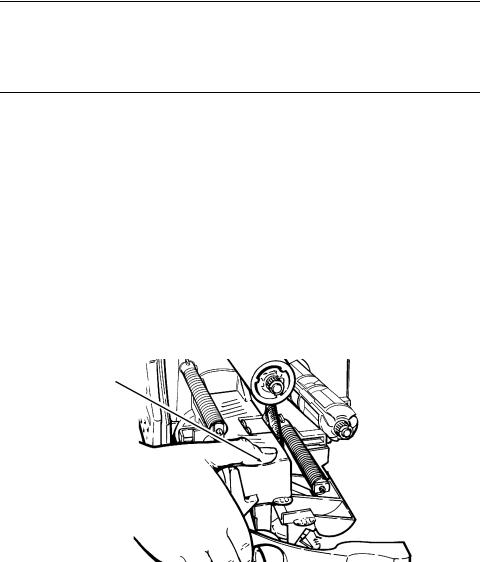
A u d i e n c e
The Operator’s Handbook is for the person who prints and applies labels.
U n p a c k i n g t h e P r i n t e r
After you unpack the printer, you should have the printer, a power cord, and a ribbon take-up core (may already be on take-up reel). Keep the box and packaging material in case the printer ever needs repair.
S h i p p i n g t h e P r i n t e r
If you need to ship the printer to a different location:
1.Remove the ribbon roll, if one is loaded.
2.Remove the supply roll, if one is loaded.
3.Close the printhead by pressing down on the thumb well until you hear it click into place.
Thumb Well
4.Place the printer in the original box and secure with packaging material. Make sure the printer is adequately packed to avoid damage during shipment. See Appendix B, "Accessories and Options" for the packaging materials part numbers.
1-2 Getting Started
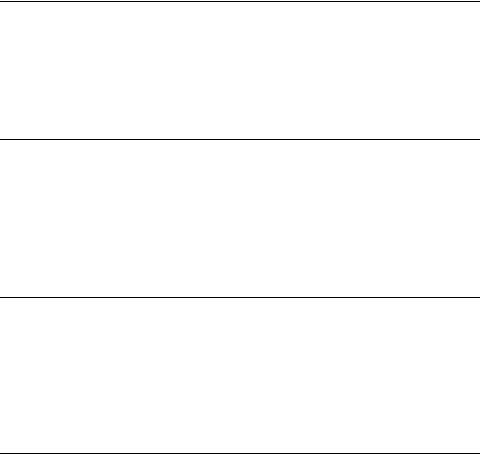
9 4 4 5 P r i n t e r O n l i n e E m u l a t i o n
The 9855 printer using 203 dpi (dots per inch) printing supports 94x5 emulation. You can send 94x5 data streams to this printer.
Refer to your 9445 Programmer’s Manual for information about 94x5 data streams.
O r d e r i n g P r o g r a m m e r ’ s M a n u a l s
The Packet Reference Manual, which describes how to create format and batch packets for printing labels, how to configure the printer online, how to diagnose printer error messages, and how to perform other advanced techniques can be downloaded from our Web site (www.paxar.com). You can print this manual or order a hard-copy version (part number TC9800PM).
A b o u t M o n a r c h ® M P C L To o l b o x U t i l i t i e s
The Monarch® MPCL Toolbox utilities are available on our Web site and are free to download. This group of development utilities helps you configure the printer, customize fonts, and download files. Monarch MPCL Toolbox utilities are not label production software. Call Customer Service for information about label production software.
C o n n e c t i n g t h e P o w e r C a b l e
The power supply automatically switches between 115V or 230V. No operator settings are required.
1.Plug the power cable into the socket. Plug the other end of the cable into a grounded electrical outlet.
2.Turn on the printer. Press ( I ) to turn on and ( O ) to turn off the printer.
Getting Started 1-3
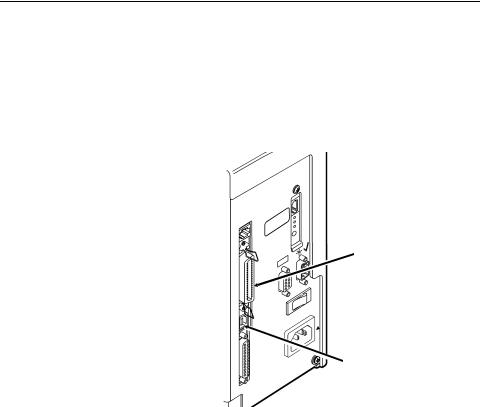
E s t a b l i s h i n g C o m m u n i c a t i o n s
Before the printer can accept print jobs from the host, you must:
Connect the communication cable to the printer and to the host.
Set the communication values on the printer to match those at the host. (Only required if you are using the serial port.)
Make sure the printer is off before connecting the cable to the communication port.
Ask your System Administrator which method you will use to communicate with the host:
Serial Communication 9 to 25 pin cable (Part #118364)
25 to 25 pin cable (Part #118366)
Parallel Port
Power Cable
 goes here
goes here
 USB Port
USB Port
Parallel Communication |
Serial Port |
|
IEEE-1284 or |
||
|
||
Centronics® mode cable (Part #118363) |
|
|
C o n n e c t i n g t h e C o m m u n i c a t i o n C a b l e |
|
Connect the communication cable into the appropriate port. Secure the cable with the connecting screws (serial) or spring clips (parallel).
If you are communicating with the host through the serial port, make sure the printer’s communication values match those at the host. The factory default values are 9600 Baud, 8 bit data frame, 1 stop bit, no parity, and DTR flow control. The printer also has a USB (Universal Serial Bus) Version 1.1 communication
port. Drivers are available on our Web site for a variety of operating systems.
1-4 Getting Started

The printer supports a baud rate up to 115200. Make sure your host is capable of communicating at the speed you
select for the printer.
U s i n g t h e C o n t r o l P a n e l
The control panel has a two-line LCD display, 2 status lights, and five buttons. The control panel displays error codes/messages, and allows you to setup/configure the printer.
P r i n t e r S t a t u s L i g h t s
Power:
The printer shows a steady green light when it is on.
The Power light blinks when the battery needs to be recharged (only on battery-powered/cart models).
Fault:
The printer shows a blinking amber light when there is a printer error.
Getting Started 1-5
B u t t o n F u n c t i o n s
Feed/Cut: |
|
|
|
Prints a label in the on-demand mode.
When the printer is online, feeds a blank label if there is no print job.
Prints a label with error information that is useful to your System Administrator if an error is displayed.
When the printer is online, cuts the supply when pressed and held for two seconds if a knife is installed.
When the printer is offline, changes the displayed value by one or 10.
Enter/Pause: When the printer is online, pauses the current print job or resumes a paused print job. When the printer is offline, selects the displayed menu item.
Escape/Clear:
l
r
When an error is present, clears the error.
When a job (batch) is printing, cancels the print job (batch). For more information about canceling batches, see "Canceling a Paused Batch" in Chapter 8.
When the printer is online (without errors), enters the offline menu mode.
When the printer is in the offline menu mode, returns the display to the next higher menu.
When the printer is in the offline menu mode, displays the previous menu item.
When the printer is in the offline menu mode, displays the next menu item.
1-6 Getting Started
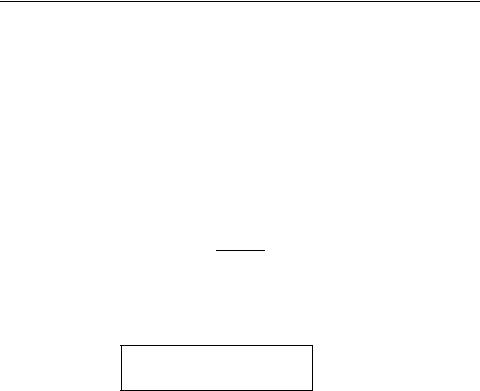
l and r |
In online mode, prints a test label when you |
|
press the buttons at the same time. Hold for |
|
one second and release. |
D i s p l a y
The display shows a three-digit error code and brief message to identify any problem the printer may have. For a description of the problem, look up the error code in Chapter 11, "Diagnostics and Troubleshooting."
S e l e c t i n g a F u n c t i o n
The Main menu has several functions (operating modes). These functions are shown in the chart below.
MAIN MENU
CANCEL |
|
|
|
|
|
BATCH |
|
|
|
REPEAT |
|
|
|
BATCH |
|
|
|
SETUP |
|
|
SCRIPTS |
|
DIAG. |
|||||||
ALL |
|
|
MODE |
|
|
|
ENTRY |
|
|
|
BATCH |
|
|
|
OPTIONS |
|
|
|
|
|
|
|||||||||
|
|
|
|
|
|
|
|
|
|
|
|
|
|
|
|
|
|
|
|
|
|
|
||||||||
|
|
|
|
|
|
|
|
|
|
|
|
|
|
|
|
|
|
|
|
|
|
|
|
|
|
|
|
|
|
|
|
|
|
|
|
|
|
|
|
|
|
|
|
|
|
|
|
|
|
|
|
|
|
|
|
|
|
|
|
|
|
|
|
|
|
|
|
|
|
|
|
|
|
|
|
|
|
|
|
|
|
|
|
|
|
|
|
|
|
|
|
|
|
|
|
SUPPLY |
|
|
CONTRAST |
|
|
DEFAULTS |
|
|
|
PORT |
|
|
|
FLASH |
|
|
|
VERIFIER |
|
|
|
||||||
|
|
|
|
|
|
|
|
|
SETTINGS |
|
|
|
MEMORY |
|
|
|
|
|
||||||||||||
|
|
|
|
|
|
|
|
|
|
|
|
|
|
|
|
|
|
|
|
|
|
|
|
|
|
|||||
|
|
|
|
|
|
|
|
|
|
|
|
|
|
|
|
|
|
|
|
|
|
|
|
|
|
|
|
|
|
|
|
|
|
|
|
|
|
|
|
|
|
|
|
|
|
|
|
|
|
|
|
|
|
|
|
|
|
|
|
|
|
If the printer displays PRINT MODE Ready when you turn it on, press Escape/Clear to display the Main menu.
To display menu options, press l or r.
When the screen displays a right arrow, press r to display more options.
MAIN MENU |
|
Cancel All |
r |
When the screen displays a left arrow, press l to display more options.
Getting Started 1-7
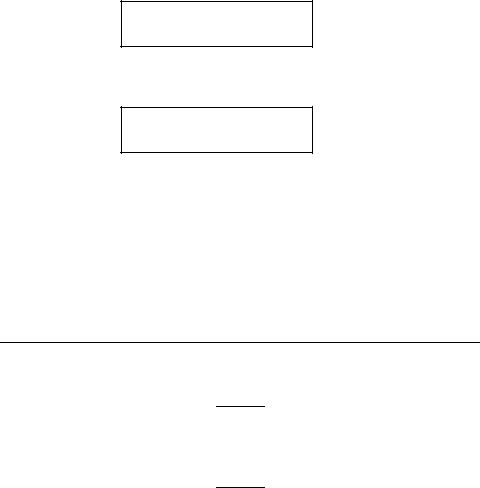
MAIN MENU
lDiagnostics
When the screen displays a left and a right arrow, press either l or r to display more options.
MAIN MENU
l Print Mode r
When you see the menu option you want, press Enter/Pause to select it.
The Main Menu controls the printer’s setup and operation. Through the Setup Menu, you can select a sub-menu for the supply, contrast, default, or port settings. Each of those sub-menus have several options, such as ribbon, speed, monetary symbols, and baud rate.
E x i t i n g a n O p t i o n
To exit an option, press Escape/Clear once. You will exit to the next higher menu.
If you press Escape/Clear from a menu, your settings are not saved. Your settings are only saved when you press Enter/Pause from a menu.
1-8 Getting Started
L O A D I N G S U P P L I E S |
2 |
This chapter describes how to load:
a roll of supply
fan-fold supply
a roll of tag supply.
There are three types of supplies:
Thermal Direct |
specially treated thermal supplies that do not |
|
use a ribbon for printing. |
Thermal Transfer |
standard supplies that require a ribbon for |
|
printing. |
High Energy |
scratch, chemical, and temperature resistant |
|
supplies that require a ribbon able to |
|
withstand high temperatures. See "Using a |
|
High Energy Ribbon" in Chapter 3 for more |
|
information. |
If you are using thermal direct supplies, do not load a ribbon.
If you switch from black mark to die cut supplies, make sure the printer’s supply type is set correctly. See "Supply Type" in Chapter 4 for more information. Your System Administrator can also send
the supply setup packet to change the supply type. Refer to the optional Packet Reference Manual for more information about
sending the supply setup packet.
Loading Supplies 2-1
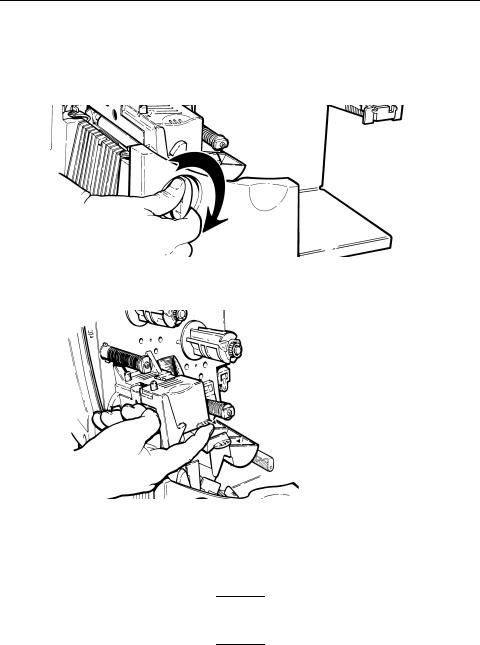
L o a d i n g L a b e l s o r Ta g s
Make sure the printer is configured for the correct supply type.
1.Open the cover.
2.Unlock the printhead by turning the retaining latch.
3.Lift printhead assembly using the printhead tab until the assembly locks into place.
 Printhead Tab
Printhead Tab
 Deflector Tab
Deflector Tab
4.Place the roll of supply on the supply holder. For labels, the supply unrolls from the top or the bottom. For tags, make sure the supply unrolls from the bottom, because tag rolls are wound face in.
Do not pick up the printer by the supply holder.
2-2 Loading Supplies
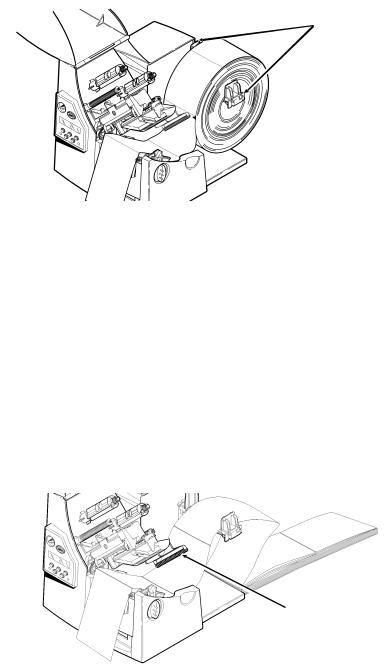
Supply Holder
Guides
 Supply Roller
Supply Roller
5.Adjust the supply holder guides so the sides barely touch the roll. Make sure the supply roll turns freely.
If you are using fan-fold supplies, place the supply stack behind the printer, label side facing up.
6.Push down on the supply lever to unlock the supply guides.
7.Lay the label strip across the supply guide so that a few inches extend past the front of the printer. Tuck the supply under the nibs and in between the die cut sensor. Do not feed supply between the supply roller and deflector.
For fan-fold supplies, lay the label strip over the supply holder and across the supply guide so that a few inches extend past the front of the printer. Tuck the supply under the nibs and in between the die cut sensor.
Supply Roller
Loading Supplies 2-3
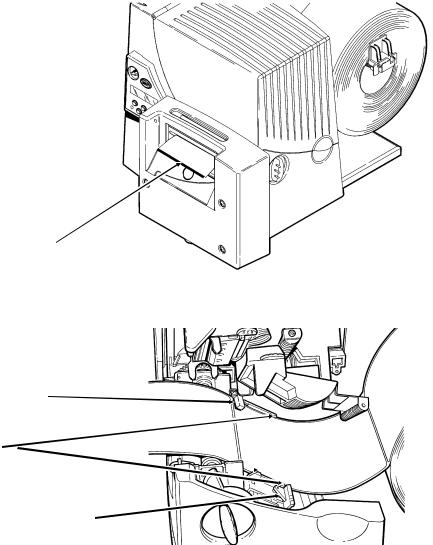
For tag supplies using the optional knife, feed the supply through the knife. Make sure at least 0.5 inches of supply is past the knife.
Tag
8.Adjust the supply guides so they touch the supply. Push up on the supply lever to lock the supply guides into place.
Die Cut
Sensor
Nibs 
Supply Lever
2-4 Loading Supplies
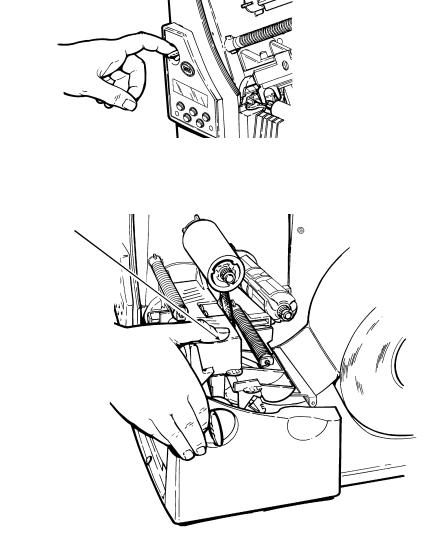
9.Hold the printhead assembly by the printhead tab while pressing down on the printhead release.
10.Close the printhead by pressing down on the thumb well until you hear it click into place.
Thumb Well
11.Close the cover.
12.Press Feed/Cut to position the supply under the printhead.
Loading Supplies 2-5
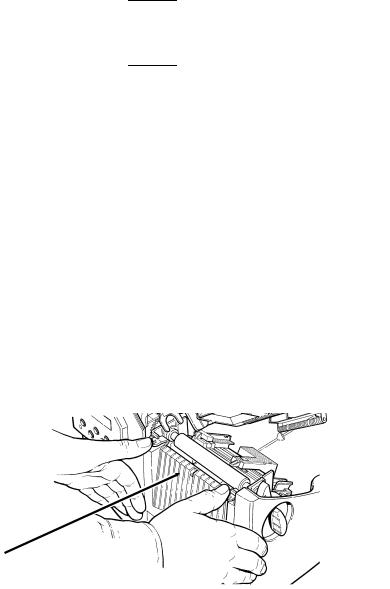
You may need to adjust the wide/narrow knobs depending on the width of your supply. See "Adjusting the Wide/Narrow Knobs" for more information.
If the printer will be unused for extended periods of time, we recommend leaving the printhead unlatched.
L o a d i n g L a b e l s f o r t h e O p t i o n a l P e e l M o d e :
Peel mode is an option that must be purchased separately. In peel mode, the printer separates the backing paper from the label. The next label is not printed until the completed one is removed from the printer. Make sure the printer is configured for on-demand mode and the correct supply type.
The minimum feed length is 1.5 inches for peel mode. We recommend using 0.5-inch gap supplies in peel mode when backfeed is disabled. Hold the leading edge of peeled labels when printing on stock longer than six inches. You must use non-perforated supplies for peel mode. Follow the steps for loading supplies from the previous section. Then, follow these steps after you close the printhead.
1.Remove the labels from the first 10 inches of the backing paper.
2.Press down on the exit cover tabs to open the exit cover on the front of the printer.
Exit Cover
2-6 Loading Supplies
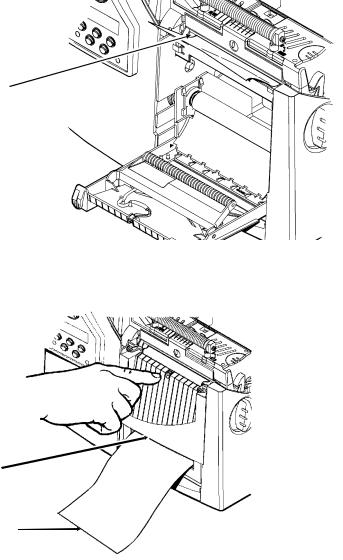
3. Feed the backing paper over the peel bar.
Peel Bar
Lower Opening
4.Feed the backing paper through the lower opening of the exit cover. Close the exit cover. Pull down on the backing paper to remove any slack.
Tear Edge
Backing Paper
When removing the backing paper, pull up across the saw-toothed tear edge. Make sure the backing paper tears at the edge.
Loading Supplies 2-7
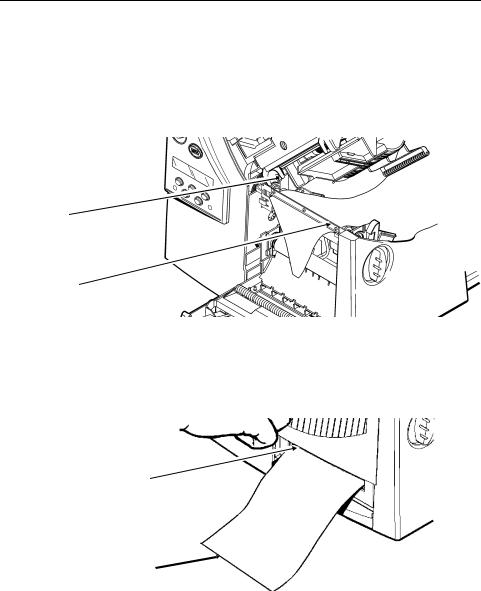
5.Close the printer’s cover.
6.Press Feed/Cut to position the supply under the printhead.
U s i n g t h e O p t i o n a l Te a r B a r
Note the following change to loading labels if you have purchased the optional tear bar. Tear labels against the tear bar. You cannot tear tags with the tear bar.
Slide the supply between the tear bar and peel bar. It may be easier if you cut one corner of the supply first.
Tear Bar
Peel Bar
Do not tear both label and backing paper at the same time.
Tear labels against the tear bar.
Tear backing paper against the tear edge.
Tear Edge
Backing Paper
2-8 Loading Supplies
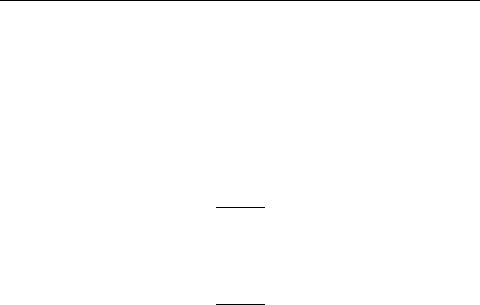
U s i n g L i n e r l e s s S u p p l y
Linerless printing is an option that must be purchased separately on the original printer order. The linerless option is not customer or field-installable.
You must use thermal direct and black mark supplies for linerless applications. The linerless printer must use on-demand mode.
For maximum platen roller life, use only wide or only narrow supplies. Switching between wide and narrow supplies may lead to uneven platen roller wear and possibly reduce the platen roller life. Use the narrow setting for linerless supplies.
To prevent jams, do not leave the printhead closed (in the locked position) longer than 30 minutes without printing. Open (unlock) the printhead before a break period, at the end of each shift, and at the end of each day.
Your linerless machine includes a shelf already installed. You can remove the shelf and add the peel edge if you are not using linerless supplies.
A d d i n g t h e P e e l E d g e o r S h e l f
1.Turn off the printer.
2.Open the cover.
3.Unlock the printhead by turning the retaining latch.
4.Lift the printhead assembly using the printhead tab until the assembly locks into place.
Loading Supplies 2-9
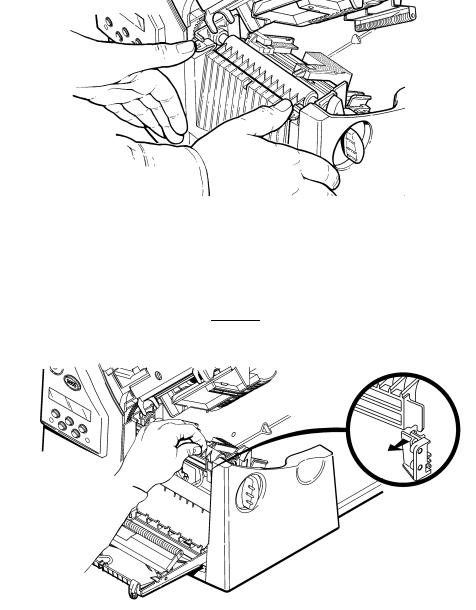
5. Press down on the exit cover tabs to open the exit cover.
6.Pull back slightly on the spring latch with your thumb or fingernail and lift the shelf out.
CAUTION
Be careful when inserting or removing the shelf. The shelf has sharp points.
2-10 Loading Supplies
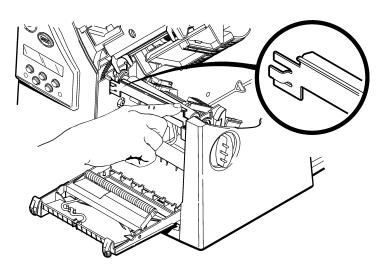
7.If inserting the peel bar:
Insert the left edge of the peel bar into the side slot at an angle. Then, slide the peel bar to the right and press down until you hear it click into place. The peel bar must be lined up with the platen roller.
8.If inserting the shelf:
Insert the left edge of the shelf into the side slot at an angle. Slide the shelf to the right, aligning it with the spring latch, and press down until you hear it click into place. The shelf must be lined up with the platen roller.
Loading Supplies 2-11
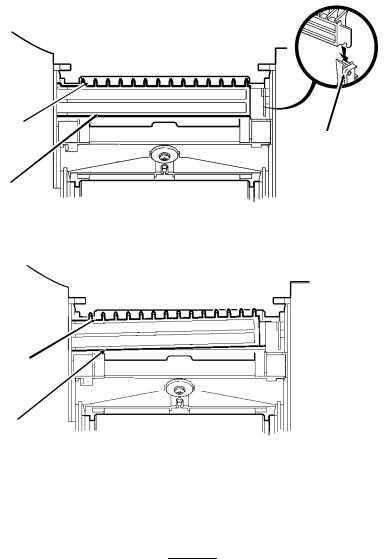
The shelf must be parallel to the platen roller, not at an angle. See the following diagrams.
Platen Roller
Spring Latch
Shelf
Shelf inserted correctly.
Platen Roller
Shelf
Shelf not inserted correctly.
CAUTION
Make sure the shelf is not misaligned with the platen roller, or damage to the platen roller could occur.
2-12 Loading Supplies

9.Close the exit cover.
10.Load supplies by following the label loading procedures. You may notice a different color and texture on the platen roller. Linerless supplies do not stick to the textured platen roller.
11.Close the printhead assembly and the cover.
12.Turn on the printer.
13.Verify the alignment of the platen roller with the peel bar or shelf. Press Feed/Cut to position the supply under the printhead.
U s i n g S t r i n g Ta g S u p p l y
String tags are used in a variety of applications, such as jewelry tags and item marking.
S t r i n g Ta g C o n s i d e r a t i o n s
Thermal direct printing, fan-fold supplies, and the knife are not supported with string tags.
The maximum print speed with string tags is 6.0 inches per second (ips).
A non-print zone of 0.250 inches (6.4 mm) exists on the string side of the tag.
Use the wide setting for string tags.
Loading Supplies 2-13
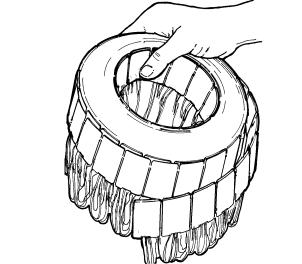
Make sure the printer is configured for the correct supply type.
1.Open the cover.
2.Unlock the printhead by turning the retaining latch.
3.Lift printhead assembly using the printhead tab until the assembly locks into place.
4.Shake the roll of string tags down to untangle the roll.
5.Place the roll of supply on the supply holder with the strings facing out.
2-14 Loading Supplies
